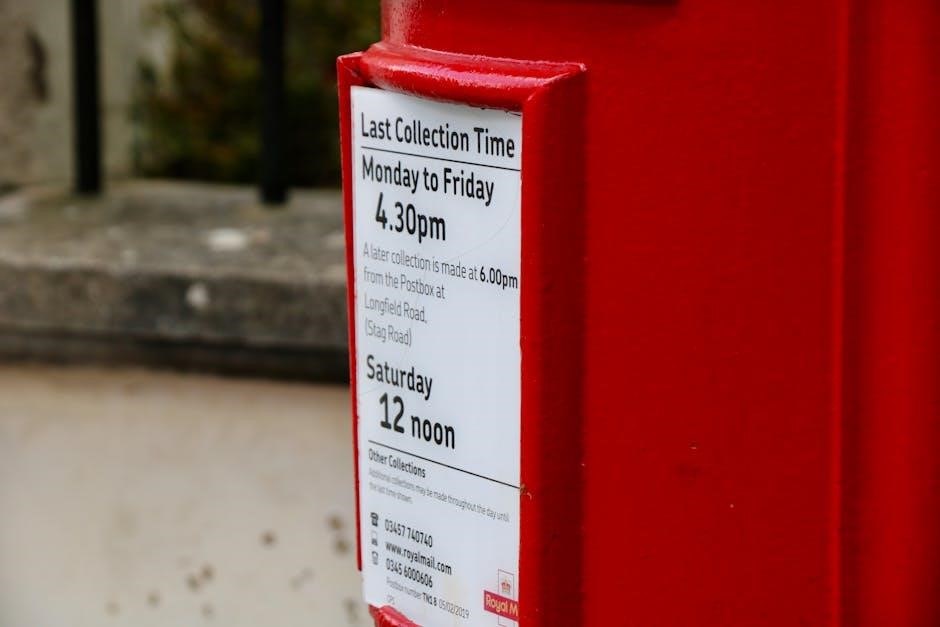Regular maintenance is crucial for optimal performance and warranty protection. The Hyundai Elantra service schedule provides a detailed guide for routine checks and replacements, ensuring reliability and longevity. Download the PDF for easy access to recommended intervals and procedures, tailored to both normal and severe driving conditions.
1.1 Overview of the Service Schedule
The Hyundai Elantra service schedule is a comprehensive guide outlining recommended maintenance intervals to ensure optimal vehicle performance. It covers both normal and severe driving conditions, providing clear timelines for inspections, replacements, and adjustments. The schedule is designed to protect your warranty, enhance reliability, and prevent potential issues. By following the outlined intervals, owners can maintain their Elantra’s health and longevity. The schedule includes mileage-based and time-based services, such as oil changes, tire rotations, and brake inspections. Whether you drive in city traffic or harsh environments, the schedule adapts to your needs. Downloading the PDF version offers convenience, allowing you to track and plan maintenance effortlessly. Regular adherence ensures your Elantra runs smoothly for years to come.
1.2 Importance of Regular Maintenance
Regular maintenance is essential for preserving the performance, safety, and longevity of your Hyundai Elantra. Neglecting scheduled services can lead to premature wear, costly repairs, and even void your warranty. By adhering to the recommended service schedule, you ensure optimal engine performance, fuel efficiency, and reliability. Routine checks help identify potential issues early, preventing breakdowns and enhancing driving safety. Additionally, regular maintenance maintains your vehicle’s resale value and ensures compliance with manufacturer guidelines. Whether driving under normal or severe conditions, consistent upkeep is vital for a smooth and trouble-free ownership experience. Downloading the Hyundai Elantra service schedule PDF provides a clear roadmap to keep your car in pristine condition.

Understanding the Service Schedule
The Hyundai Elantra service schedule outlines maintenance requirements based on mileage and time, ensuring optimal performance under both normal and severe driving conditions. It includes key services like oil changes, tire rotations, and inspections, with detailed intervals to follow. The PDF guide provides a clear, organized format for tracking essential upkeep, helping owners stay proactive about their vehicle’s health and longevity.
2.1 Normal Driving Conditions
Normal driving conditions for the Hyundai Elantra include typical urban or highway driving, with moderate temperatures and no extreme stress on the vehicle. The service schedule is designed to ensure optimal performance under these conditions, with recommended maintenance intervals based on mileage and time. For example, oil changes are typically required every 5,000 to 7,500 miles, while tire rotations are suggested every 6,000 to 8,000 miles. The schedule also includes inspections of key components like brakes, belts, and fluids to prevent wear and tear. By following these guidelines, owners can maintain their Elantra’s reliability and performance, while also protecting their warranty. Regular maintenance under normal conditions ensures a smooth and efficient driving experience.
2.2 Severe Driving Conditions
Severe driving conditions, such as frequent stop-and-go traffic, extreme temperatures, or towing, require more frequent maintenance for your Hyundai Elantra. The service schedule adjusts intervals to ensure the vehicle remains reliable under stress. For example, oil changes may be needed more often, every 3,000 to 5,000 miles, to combat engine wear. Additionally, inspections of brakes, coolant, and transmission fluid become critical to prevent overheating and damage. Drivers in areas with heavy dust or salted roads should also prioritize undercarriage cleaning and rust-proofing. Following these adjusted guidelines helps maintain performance and longevity, even in challenging environments. Always consult the PDF guide for specific recommendations tailored to your driving habits and conditions.
2.3 Key Maintenance Services

Regular maintenance for the Hyundai Elantra includes essential services like oil changes, tire rotations, and brake inspections. Oil changes are typically required every 5,000 to 7,500 miles to ensure engine longevity. Tire rotations should occur every 6,000 to 8,000 miles to maintain even tread wear. Brake pads and rotors need inspection every 12,000 miles, while the battery should be checked every 3 years or 50,000 miles. Fluid replacements, such as coolant and transmission fluid, are recommended at specific intervals to prevent corrosion and wear. These services are crucial for maintaining performance, fuel efficiency, and overall reliability. The service schedule PDF provides detailed guidelines to help owners stay on track with these critical maintenance tasks.

Downloading the Service Schedule PDF
The Hyundai Elantra service schedule PDF is available on Hyundai’s official website and other reputable sources. It provides a comprehensive guide to maintenance intervals and procedures, ensuring easy access to essential information for optimal vehicle care.
3.1 Sources for the PDF
The Hyundai Elantra service schedule PDF can be downloaded from various reliable sources. The official Hyundai website provides the most accurate and up-to-date version. Additionally, authorized Hyundai dealerships often offer the PDF for free to customers. Third-party websites like CarManualsOnline and WorkshopCarManuals also host the document, though verification of authenticity is recommended. Owners can also access the PDF through the Hyundai app or by contacting customer support. For older models, forums and communities like MOTOR-TALK may have archived versions available. Always ensure the PDF is downloaded from trusted sources to avoid incorrect or outdated information.
3.2 Benefits of the PDF Guide
The Hyundai Elantra service schedule PDF offers a clear and convenient guide for maintaining your vehicle. It provides detailed maintenance intervals, ensuring you never miss critical services. The PDF is organized, making it easy to track oil changes, tire rotations, and inspections. By following the guide, you can enhance your car’s performance, fuel efficiency, and longevity. It also helps prevent unexpected repairs and maintains warranty coverage. The PDF is accessible on any device, allowing you to reference it anytime. Whether you’re a DIY enthusiast or prefer professional service, the guide empowers you to make informed decisions. Regular maintenance, as outlined, ensures your Elantra runs smoothly and retains its value over time.

Service Intervals
Hyundai Elantra service intervals are designed to ensure optimal performance and longevity. Typically, maintenance is required every 5,000 to 7,500 miles or 6 months, depending on driving conditions.
4.1 Mileage-Based Intervals
The Hyundai Elantra service schedule outlines specific maintenance requirements based on mileage. Typically, routine services are recommended at intervals of 5,000 to 7,500 miles. At 15,000 miles, essential checks include oil changes, tire rotations, and inspections of belts and hoses. By 30,000 miles, additional services like air filter replacements and brake inspections are advised. At 60,000 miles, more comprehensive maintenance is required, including spark plug replacements and belt inspections. Adhering to these mileage-based intervals ensures optimal performance, prevents potential issues, and maintains warranty coverage. Regular maintenance tailored to your driving habits and mileage ensures your Elantra runs smoothly for years to come.
4.2 Time-Based Intervals
In addition to mileage-based maintenance, the Hyundai Elantra service schedule includes time-based intervals to ensure consistent vehicle care. Services are recommended every 6 months or 12 months, depending on the type of maintenance required. For example, tire rotations and inspections are typically suggested every 6 months, while oil changes and other fluid checks may align with these intervals. Time-based schedules ensure that even vehicles with low mileage receive regular attention, preventing issues related to fluid degradation or component wear over time. This approach complements mileage-based intervals, providing a comprehensive maintenance plan that addresses both usage and time-related factors. Regular time-based maintenance helps maintain optimal performance and extends the vehicle’s lifespan.
4.3 Additional Interval Considerations
Beyond mileage and time-based intervals, the Hyundai Elantra service schedule includes additional considerations to ensure optimal vehicle health. Factors such as extreme temperatures, frequent towing, or high-performance driving may require more frequent maintenance. For instance, brake fluid replacements and battery checks should be performed every 2-3 years or as needed. Additionally, drivers in areas with heavy pollution or extreme weather conditions may need to adjust their maintenance frequency. It’s important to refer to the owner’s manual or consult a Hyundai service center for personalized recommendations. These extra considerations ensure the Elantra performs reliably under various driving conditions and extends its lifespan. Regular inspections and timely adjustments are key to maintaining peak performance and avoiding unexpected repairs.

Severe Driving Conditions
Severe driving conditions, such as frequent stop-and-go traffic, extreme temperatures, or towing, require more frequent maintenance. These factors can affect your Hyundai Elantra’s performance and longevity.
5.1 Factors Influencing Severe Conditions
Severe driving conditions for the Hyundai Elantra include frequent stop-and-go traffic, extreme temperatures, and towing. These factors can accelerate wear on components like the battery, brakes, and engine. Additionally, short drive cycles, where the engine doesn’t fully warm up, can lead to increased maintenance needs. Drivers in urban areas or those who frequently carry heavy loads should pay special attention to these factors. The service schedule PDF outlines specific adjustments for such conditions, ensuring optimal performance and longevity. Ignoring these factors can result in premature wear and higher repair costs over time. Regular inspections and adjustments are crucial to maintain reliability under severe usage.
5.2 Adjustments for Severe Usage
For Hyundai Elantra owners who drive under severe conditions, adjustments to the maintenance schedule are necessary. This includes more frequent oil changes, typically every 3,000 to 5,000 miles, and earlier replacement of components like the air filter and spark plugs. Drivers in extreme climates or those who tow trailers should also inspect brakes and coolant systems more often. The service schedule PDF provides specific guidelines for these adjustments, ensuring the vehicle remains reliable under harsh conditions. Timely adjustments help prevent premature wear and potential damage, maintaining the Elantra’s performance and extending its lifespan. Regular monitoring and proactive maintenance are key to handling severe usage effectively.
DIY Maintenance Tips
Regular oil changes, tire pressure checks, and air filter inspections are essential DIY tasks. Refer to the Hyundai Elantra service schedule PDF for detailed guidance and intervals.
6.1 Essential DIY Maintenance Tasks

Regular DIY maintenance is key to extending your Hyundai Elantra’s lifespan. Start with oil changes every 5,000 to 7,500 miles, using the recommended viscosity. Check and maintain proper tire pressure, as specified in the owner’s manual, to improve fuel efficiency and handling. Inspect and replace the air filter every 15,000 to 30,000 miles to ensure optimal engine performance. Additionally, monitor battery health, clean terminals, and test charge levels annually. Rotate tires every 6,000 to 8,000 miles for even wear. Inspect belts and hoses for cracks or damage, and replace them as needed. Refer to the Hyundai Elantra service schedule PDF for detailed intervals and procedures to keep your vehicle in top condition.
Professional Service Recommendations
For optimal results, schedule regular maintenance with authorized Hyundai dealers. Their expertise ensures adherence to the Hyundai Elantra service schedule PDF, using genuine parts and advanced techniques.
7.1 Benefits of Dealer Service
Choosing an authorized Hyundai dealer for your Elantra’s maintenance ensures adherence to the Hyundai Elantra service schedule PDF. Dealerships employ factory-trained technicians who understand your vehicle’s specific needs. They use genuine Hyundai parts, guaranteeing quality and compatibility. Additionally, dealer service protects your warranty and enhances resale value. Dealers also have access to advanced diagnostic tools and the latest updates, ensuring precise and efficient repairs. Scheduling regular maintenance with a dealer provides peace of mind, knowing your car is in expert hands. This level of professionalism and attention to detail is unmatched, making it a wise investment for long-term reliability and performance.
Cost of Maintenance
The average maintenance cost for a Hyundai Elantra is moderate, with routine services like oil changes and tire rotations being relatively affordable. Adhering to the service schedule PDF helps prevent costly repairs by addressing issues early, ensuring long-term savings and reliability.
8.1 Average Maintenance Costs
The average maintenance costs for a Hyundai Elantra are moderate, ensuring affordability for most drivers. Routine services, such as oil changes and tire rotations, are relatively inexpensive. Adhering to the service schedule PDF helps prevent costly repairs by addressing potential issues early. Typical maintenance expenses include parts and labor for items like air filters, brake pads, and belts. Over time, following the recommended schedule can lead to significant savings by avoiding major repairs. Additionally, the Elantra’s reliability minimizes unexpected costs, making it a cost-effective choice for commuters and city drivers. Regular maintenance not only protects your investment but also ensures optimal performance and longevity.
Common Maintenance Issues
Common issues include oil leaks, battery degradation, and brake wear. Regular inspections, as outlined in the Hyundai Elantra service schedule PDF, help identify and address these problems early.
9.1 Identifying Common Issues
Identifying common issues in your Hyundai Elantra begins with monitoring its performance. Look for signs like unusual noises, warning lights, or decreased efficiency. Oil leaks, battery degradation, and brake wear are frequent concerns. Regular inspections, as detailed in the Hyundai Elantra service schedule PDF, can help detect these problems early. Pay attention to changes in exhaust sounds, vibrations, or steering issues, as these may indicate underlying mechanical problems. By addressing these issues promptly, you can prevent costly repairs and ensure your vehicle runs smoothly. Always consult the PDF guide for specific maintenance recommendations tailored to your driving conditions.

Troubleshooting Maintenance Problems
Troubleshooting maintenance issues in your Hyundai Elantra involves identifying common problems like oil leaks, battery degradation, or brake wear. Refer to the service schedule PDF for diagnostic guidance and solutions to ensure timely repairs and optimal performance.
10.1 Common Maintenance Problems
Common maintenance issues for the Hyundai Elantra include oil leaks, battery degradation, and brake wear. Oil leaks often occur due to worn engine gaskets or loose connections. Battery problems may arise from extreme temperatures or faulty charging systems. Brake wear is accelerated by frequent city driving or aggressive braking.
Other issues include coolant leaks, worn belts, and faulty sensors. Regular inspections, as outlined in the service schedule PDF, can help identify these problems early. Addressing them promptly prevents costly repairs and ensures optimal performance.
By following the recommended maintenance intervals, Elantra owners can minimize these common issues and maintain their vehicle’s reliability over time.
Service Reset Procedure
After completing scheduled maintenance, reset the service indicators using the instrument cluster or a scan tool. This ensures accurate tracking of future service needs and maintains system functionality.

11.1 Steps to Reset Service Indicators
To reset the service indicators on your Hyundai Elantra, follow these steps: Turn the ignition to the “ON” position without starting the engine. Use the steering wheel controls to navigate to the “Settings” or “Vehicle Info” menu on the instrument cluster. Select “Service Reminder” or “Maintenance Info” and choose the option to reset the service interval. Confirm the reset by following the on-screen prompts. If equipped, some models may require a scan tool for this process. Always consult your owner’s manual or contact a certified Hyundai technician for assistance. Properly resetting the service indicators ensures accurate tracking of maintenance needs and prevents unnecessary reminders.
Model-Specific Service Information
The Hyundai Elantra service schedule varies slightly across different models and years. Always refer to your specific vehicle’s owner’s manual for accurate maintenance requirements and recommendations.
12.1 Variations Across Models
Hyundai Elantra maintenance schedules vary slightly across different models and years. While some services are consistent, specific procedures may differ based on engine type, transmission, and features. For instance, the 2024 Elantra may have unique recommendations compared to earlier models. Factors like driving conditions and optional equipment also influence the schedule. Always consult the owner’s manual or contact a Hyundai dealer for precise details tailored to your vehicle. This ensures compliance with warranty requirements and optimal performance. Variations are designed to address the unique needs of each model, ensuring reliability and longevity. Refer to the PDF guide for your specific Elantra to avoid confusion and maintain your car effectively.

Reliability and Longevity
Regular maintenance significantly enhances the Hyundai Elantra’s reliability and longevity. Adhering to the service schedule ensures optimal performance, prevents issues, and extends the vehicle’s lifespan, keeping it running smoothly for years.
13.1 Impact of Maintenance on Reliability
Proper maintenance significantly boosts the Hyundai Elantra’s reliability. Regular servicing ensures all components function optimally, reducing the risk of unexpected breakdowns. By following the recommended schedule, owners can maintain their vehicle’s performance and longevity. Download the PDF to access detailed guidelines tailored to both normal and severe driving conditions. Consistent upkeep not only prevents major repairs but also enhances safety and fuel efficiency. Neglecting scheduled maintenance can lead to premature wear and costly damages. Therefore, adhering to the service schedule is essential for preserving the Elantra’s reliability and ensuring it remains a dependable choice for years to come.
Conclusion
Regular maintenance is key to extending the life of your Hyundai Elantra. Follow the service schedule to ensure optimal performance, reliability, and warranty protection. Download the PDF for a comprehensive guide.
14.1 Recap of Key Points
Regular maintenance is essential for the Hyundai Elantra to ensure optimal performance and longevity. The service schedule outlines specific intervals for tasks like oil changes, tire rotations, and inspections. Normal and severe driving conditions require different maintenance approaches, with severe conditions demanding more frequent servicing. The PDF guide provides a detailed roadmap, making it easier to track and perform necessary services. DIY maintenance tasks, such as fluid checks, can save time and money. Professional service is recommended for complex procedures to maintain warranty validity. Staying informed about service intervals and adjustments ensures your Elantra runs smoothly for years. Always refer to the official Hyundai Elantra service schedule PDF for accurate and model-specific guidance.

